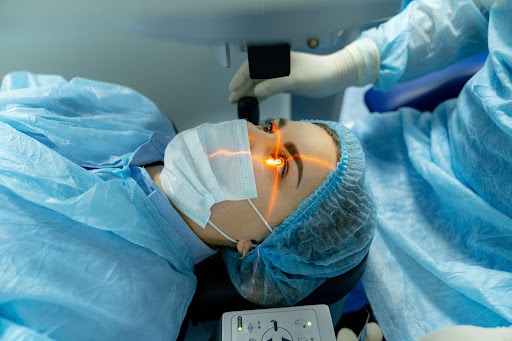Eye Care
Dos and Don’ts for Successful Laser Cataract Surgery: A Comprehensive Guide

by admin
26th September 2023
9 minutes read
LASIK and its Types
LASIK (Laser-Assisted In Situ Keratomileusis) surgery has transformed the lives of millions, offering a safe and effective solution to correct vision problems such as myopia (nearsightedness), hyperopia (farsightedness), and astigmatism. This popular refractive surgery utilizes advanced laser technology to reshape the cornea, eliminating the need for glasses or contact lenses. While LASIK has a high success rate, it’s essential to be well-informed and prepared to ensure the best possible outcome.
There are different types of LASIK procedures, each tailored to meet specific vision correction needs:
Traditional LASIK: This is the most common form of LASIK surgery. It involves creating a thin flap on the cornea using a microkeratome or a femtosecond laser. The flap is then lifted, and the underlying corneal tissue is reshaped using an excimer laser. After the cornea is reshaped, the flap is repositioned, where it adheres without the need for stitches.
Bladeless LASIK: Also known as “All-Laser LASIK” or “IntraLASIK,” this variation utilizes a femtosecond laser to create the corneal flap instead of a microkeratome. The rest of the procedure remains the same as traditional LASIK. Bladeless LASIK can offer increased precision and reduce certain flap-related complications.
Custom LASIK: This procedure uses wavefront technology to create a detailed map of the eye, identifying even subtle irregularities in the cornea. The excimer laser is then guided by this map to perform a more personalized and precise corneal reshaping. Custom LASIK can provide better results in addressing higher-order aberrations, leading to enhanced visual outcomes.
PRK (Photorefractive Keratectomy): PRK is another laser eye surgery that is an alternative to LASIK. Instead of creating a corneal flap, the surgeon removes the outer layer of the cornea (epithelium) entirely before reshaping the underlying corneal tissue with an excimer laser. PRK is suitable for individuals with thin corneas or specific corneal conditions that may not qualify for LASIK.
Each type of LASIK procedure has its advantages and potential drawbacks, depending on individual eye characteristics and refractive errors. It is crucial for potential candidates to undergo a comprehensive eye examination and consult with a qualified ophthalmologist to determine the most suitable LASIK approach to achieve optimal vision correction results.
In this comprehensive blog, we will explore the crucial dos and don’ts for LASIK surgery, empowering you to make informed decisions and enjoy the full benefits of this life-changing procedure.
Dos And Don’ts For Lasik Surgery
I. Understanding LASIK Surgery
LASIK surgery is a quick and painless outpatient procedure that aims to improve vision by reshaping the cornea’s curvature. The cornea is the clear, front part of the eye responsible for refracting light onto the retina. During LASIK surgery, a microkeratome or femtosecond laser creates a thin flap in the cornea. The surgeon then uses an excimer laser to remove precise amounts of corneal tissue, correcting refractive errors and improving vision clarity.
II. Preparing for LASIK Surgery
Do: Choose a Qualified and Experienced Surgeon
Selecting the right surgeon is paramount to the success of your LASIK procedure. Look for a board-certified ophthalmologist with extensive experience in performing LASIK surgery. Research patient reviews and testimonials to ensure you are comfortable with your choice.
Don’t: Base Your Decision Solely on Cost
LASIK surgery is an investment in your vision and quality of life. While it’s natural to consider costs, making your decision solely based on price can compromise safety and outcomes. Choose a reputable surgeon with a track record of successful LASIK procedures, even if the cost is higher.
Do: Attend a Comprehensive Consultation
Before proceeding with LASIK surgery, attend a thorough consultation with your surgeon. They will evaluate your eye health, assess your refractive error, and discuss your expectations to determine your candidacy for the procedure. Candidacy depends on factors such as corneal thickness, pupil size, and overall eye health.
Don’t: Wear Contact Lenses Before the Evaluation
To ensure accurate measurements and evaluations, avoid wearing contact lenses for a specific period before your LASIK consultation. Contact lenses can alter the cornea’s shape and affect the accuracy of pre-operative measurements.
III. The Day of LASIK Surgery
Do: Arrange Transportation
LASIK surgery is an outpatient procedure, and you will not be able to drive yourself home afterward. Arrange for a friend or family member to drive you to and from the surgical center.
Don’t: Wear Eye Makeup or Fragrances
On the day of LASIK surgery, refrain from wearing eye makeup, lotions, or fragrances. These substances can interfere with the surgical equipment and increase the risk of infection.
Do: Follow Pre-Operative Instructions
Your surgeon will provide specific pre-operative instructions, such as fasting before the surgery. Adhere to these guidelines to ensure a smooth and safe surgical experience.
IV. During LASIK Surgery
Do: Relax and Follow Instructions
During LASIK surgery, it’s natural to feel anxious. However, trust your surgeon and the medical team. The procedure is typically painless and lasts only a few minutes per eye. Follow your surgeon’s instructions, such as where to look and when to keep your eye steady.
Don’t: Panic or Make Sudden Movements
It’s essential to remain calm and still during the procedure. Sudden movements or attempts to touch your eyes can disrupt the surgery and increase the risk of complications.
Do: Communicate with Your Surgeon
If you experience any discomfort or have questions during the procedure, don’t hesitate to communicate with your surgeon. They will ensure you are comfortable and informed throughout the process.
Do: Rest and Follow Recovery Guidelines
After LASIK surgery, rest your eyes and avoid any strenuous activities for the first 24 to 48 hours. Follow your surgeon’s recovery guidelines, which may include using prescribed eye drops and wearing protective eye shields while sleeping.
Don’t: Rub or Touch Your Eyes
Resist the urge to rub or touch your eyes during the healing process. This can disrupt the corneal flap and potentially cause complications.
Do: Attend All Follow-Up Appointments
Attend all scheduled post-operative appointments with your surgeon to monitor your healing progress. These visits are crucial for ensuring the surgery’s success and addressing any concerns.
VI. Long-Term Eye Care
Do: Protect Your Eyes from UV Exposure
UV rays can be harmful to your eyes, even after LASIK surgery. Wear sunglasses with UV protection when outdoors to shield your eyes from harmful sun exposure.
Don’t: Skip Regular Eye Exams
While LASIK surgery can significantly improve your vision, it’s essential to maintain regular eye exams to monitor your eye health and address any changes in your vision over time.
Do: Follow Proper Eye Hygiene
Adopt good eye hygiene practices to prevent eye infections and other complications. Wash your hands before touching your eyes and avoid sharing eye makeup or contact lenses with others.
Conclusion
LASIK surgery is a life-changing procedure that can provide clearer vision and reduce or eliminate the need for glasses or contact lenses. By adhering to the dos and don’ts outlined in this comprehensive guide, you can optimize your LASIK experience and maximize the benefits of the procedure. Remember, LASIK surgery is a decision that should be made with careful consideration and professional guidance. Consult with a qualified ophthalmologist to determine if LASIK is the right choice for your unique vision needs and embark on the journey to a brighter, clearer future.
How Can Medfin Help?
Medfin is a daycare surgery expert providing access to the latest surgical procedures and top doctors in your city at affordable prices. Medfin provides you access to best cataract surgeon in bangalore with 10+ years of experience . With Medfin, you can leave your hassles behind and focus on your health. From instant consultations to paperwork assistance, we have got you covered with everything. So why wait? Call us today!
FAQs
1. What is LASIK surgery, and how does it work?
LASIK (Laser-Assisted In Situ Keratomileusis) is a popular eye surgery designed to correct refractive vision problems, such as nearsightedness, farsightedness, and astigmatism. During the procedure, the surgeon uses a laser to reshape the cornea, the clear front part of the eye, to improve how light is focused on the retina. By altering the cornea’s curvature, LASIK aims to enhance visual acuity and reduce the need for glasses or contact lenses.
2. How safe is LASIK surgery?
LASIK is considered safe and effective for many patients. The procedure has a high success rate, with most people experiencing improved vision immediately or shortly after surgery. However, like any surgical procedure, LASIK carries some risks and potential complications, such as dry eyes, halos, glare, and overcorrection or undercorrection. A thorough pre-operative evaluation with an experienced eye surgeon helps identify suitable candidates and minimize risks.
3. Who is a good candidate for LASIK surgery?
Ideal candidates for LASIK are typically adults over 18 years old with stable vision and healthy corneas. Individuals with mild to moderate refractive errors, good overall eye health, and no significant eye conditions are often suitable candidates. Pregnant or nursing women, those with certain health conditions (e.g., autoimmune disorders), and individuals with thin or irregular corneas may not be suitable candidates.
4. What should I expect during and after the LASIK procedure?
LASIK is typically an outpatient procedure, and it is generally performed under local anesthesia. The surgeon creates a thin flap on the cornea using a microkeratome or femtosecond laser, and then the excimer laser is used to reshape the cornea. The procedure is relatively quick, usually lasting around 15 minutes per eye. After LASIK, patients may experience mild discomfort and blurry vision, but this usually subsides within a few days. Full recovery can take several weeks, during which the eyes should be protected from irritants and rubbing.
5. How long does the LASIK effect last, and are there any limitations post-surgery?
The effects of LASIK are often permanent, but the eyes can change over time due to age-related factors. While most people maintain improved vision for many years after the procedure, some may require follow-up enhancements or continue wearing glasses for specific activities (e.g., reading or driving at night). Following LASIK, patients should attend regular eye check-ups to monitor their vision and overall eye health. It’s also essential to avoid eye injuries and protect the eyes from UV radiation by wearing sunglasses when outdoors.
CATEGORIES
- ACL Reconstruction
- Anal Fissures
- Anal Fistula
- Appendicitis
- ASK A DOCTOR
- Benign Prostatic Hyperplasia
- Breast Lump Excision
- Cataract
- Circumcision
- Conditions & Diseases
- Cosmetology
- Covid-19
- Cure
- Endocrinology
- ENGLISH VIDEOS
- Eye Care
- Gallstones
- General Surgeries
- Government Schemes
- Gynaecology
- Gynecomastia
- Health
- Health Insurance
- Hernia
- hindi
- Hip Arthoscopy
- Hip Replacement
- Hip Replacement Surgery
- Hydrocele
- Kannada
- Kidney Stones
- Knee Arthroscopic
- Laparoscopic
- LASER
- Latest Treatments
- Lifestyle
- Liposuction
- Medfin Stories
- Medicine
- Nephrology
- Ophthalmology
- Orthopaedic
- Paraphimosis
- Patient Testimonials
- PCL Reconstruction
- Phimosis
- Piles (Hemorrhoids)
- Pilonidal Sinus
- Proctology
- Prostate Artery Embolization
- Rhinoplasty
- Second Opinion
- Total Knee Replacement
- Uncategorised
- Urology
- uterine artery embolization
- Uterine Fibroids
- Varicocele
- Varicose Veins
- Vascular
- VIDEOS






